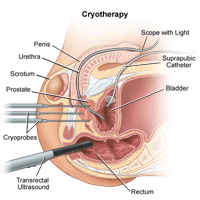Specialized Types of Cancer Surgery
In most cases, cancer treatment depends on your overall health and how well you can handle surgery. It also depends on the type and the stage of the cancer, the outlook (prognosis), other available choices, and your personal preferences. Your healthcare provider may advise surgery as part of cancer treatment to remove tumors or to take out tissue for testing (biopsy). It may also be done to reconstruct a part of the body affected by the cancer. Your provider may think it's the best way to treat the cancer.
In addition to traditional surgery, your healthcare team may advise 1 of several different types of surgery as part of your cancer treatment.
Cryosurgery
 |
| Cryotherapy for prostate cancer. Click image to enlarge |
This type of surgery destroys cancer cells by freezing them. The surgeon takes care to try to keep healthy cells and tissue from being frozen along with the cancer cells.
Cryosurgery may be advised for many types of cancer:
-
Skin cancer
-
Liver cancer
-
Cervical cancer or precancer
-
Prostate cancer that is only in the prostate
-
Bone cancer
-
Retinoblastoma, a cancer of the eye that occurs in childhood
-
Lung cancer
Several different procedures can be used to freeze cancer cells. For instance, to treat skin cancer, cells are often frozen using liquid nitrogen or argon gas. This may be sprayed or applied right on the skin. To treat tumors in the body, a thin tube is put into the tumor. The tip of the tube puts intense cold on the tumor. This destroys the cancer. During this procedure you are given medicine (anesthesia) that puts you into a deep sleep.
Risks and side effects include some bleeding and scabbing at the site of the cryosurgery. Depending on where the tumor is, you may have other side effects. These include hair loss if it's outside the body, spotting for treatment of a cervical cancer, or coughing up blood if it's treatment for lung tumors.
Laser surgery
Laser surgery uses a focused, high-powered beam of light to destroy cancer cells. It's often used to control tumors that are causing certain symptoms because of their size or location. Lasers may be used alone or with other cancer treatments, such as chemotherapy or radiation therapy.
Lasers tend to be more accurate than scalpels. So they are better able to spare healthy tissue and cause less bleeding and scarring. The laser surgery's effectiveness may not last as long. This means you may need to have the procedure again. Healthcare providers who use lasers need special training and expensive equipment. This method of surgery may not be readily available at all surgery centers or hospitals.
Laser surgery can play a role in treating or managing many types of cancer, including:
Microsurgery
This type of surgery is used when work must be done on a very small scale. The surgeon will use a magnifying tool to do the surgery. Microsurgery might be used to reconnect blood vessels and small areas of tissue that have been cut or disrupted during surgery.
Microsurgery needs special surgical training and equipment. Mohs surgery is a type of microsurgery used to get better cosmetic effects in areas where removing the least possible amount of tissue is important. For example, it may be done for skin cancer surgery on the face.
Electrosurgery
This method uses high-frequency current to burn away (cauterize) abnormal cells as well as nearby healthy cells. This method is advised for cancers of the mouth, throat, skin, and cervix. It may also be used during other procedures.
This is a minimally invasive approach that is a good choice when a cancer may have spread. Minimally invasive means less cutting and less blood loss, compared with other types of surgery. This treatment also seals blood vessels close to the abnormal tissue. So reduced bleeding is 1 benefit. Radiofrequency ablation and microwave surgery are other types of minimally invasive surgery.
One of the risks of electrosurgery is heat damage to nearby tissue. Side effects will vary with the type and location of cancer.